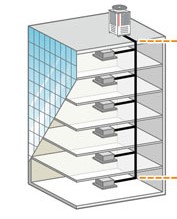The amount of time we spend in closed spaces has increased much at a larger pace than the previous generations. Popularity of HVAC systems for thermal comfort has made it easy for building designers to opt for very large indoor spaces. How clean is the air we breath while staying indoors?
Indoor Air Quality Depletion
Air quality gradually depletes inside a closed space due to emissions from occupants, Volatile Organic Compounds (VOC) emitted from furniture and other sources, burning fuels, Asbestos particles from roof, tobacco, fungi, microorganisms such as virus and bacteria etc. Outside air is cleaner and gets automatically purified with plants, sunlight and wind. For indoor air one need to provide a combination of cleaning mechanisms in order to keep it healthy for the occupants.
What does a Room Air conditioner Do?
A room air conditioner is primarily designed to create thermal comfort in a closed space. It circulates room air and the equipment heats or cools the air. Coarse particles of sizes above 10 micron is normally filtered with nylon filters in a room air conditioner.
Given that indoor living can’t be avoided, ways and means to purify air is important. Assessing and maintaining Indoor Air Quality is expensive and often compromised. The following is a discussion about indoor air pollutants and means to control them. This discussion is not an in depth idea sharing but may help people to understand the basic practices which are to be followed while living indoors and assess the risks associated.
Indoor Air Pollutants & Purification Process – Basics
Purification of air can involve one or more processes depending on the nature of the pollutant and concentration. Exhausting contaminated air, inducing clean outside air, air filtration etc are common processes
Scope of the indoor air purification processes and applicability
- CO2, VOC, and gaseous pollutants are diluted by inducing outside air. Freely inducing outside air will add load to the HVAC system. Hence controlled ventilation is required. Care must be taken that the out side air is taken from a clean location
- Particulates are filtered with various grades of air filters. Even bacteria and virus to a very high extent can be filtered with HEPA filters. HEPA filtration is comparatively expensive way as
- Oil, mist etc. are removed by Electro static Precipitator (ESP) modules
- Pathogens can be killed with UV lamps in air stream in HVAC ducts.
The applicability of the processes vary for different facilities. In case of a pharma facility particle filtration predominates while for a health care facility for tuberculosis patients, disinfecting methods are important. For a commercial facility with larger occupancy, CO2 levels may go high and focus is more on to that.
While designing any closed living space, indoor air quality enhancement strategy is to be meditated well in advance. Many of the diseases of unknown sources are linked to indoor air quality. The diseases arising due to poor indoor air quality can be either a short term or a long term one.
Sick Building Syndrome & Longterm Health Impacts
In ain air conditioned room, indoor air is continuously recirculated and the quality of air depletes gradually and the level of pollutants increases. This cause short term and long term health issues to the occupants. Sick conditions arising out of indoor air is termed as sick building syndrome
Short Term
Long term
- head ache, dizziness, vomiting
- Eye, nose and throat irritation
- Breathing issues
- Lung cancer
- kidney and liver disfunctions
- Nervous system diseases
Sick building syndrome adversely affects productivity of employees in a work place. One way of limiting indoor pollution is source control. Identify the source and eliminate the pollutant at source itself. Another way is to control the environment
Source Control
Environment Control
- Provide hood for fuel burning source
- Separate smoking zone
- Select paints which emit less chemicals
- Provide sufficient ventilation
- Filtering of particulates
- Using safer germicides to kill microbes
Identifying Symptoms
It is important that the facility administrator understand the symptom and take necessary steps in time if there is any IAQ related issues. Because of the artificial thermal comfort created by the HVAC system, there are chances that people seldom notice the air quality issues if not ever. Commercial establishments with poor Indoor Air Qualities will have combinations of the following symptoms
- Higher level of employee absenteeism
- Employees reporting head ache especially after a few hours of working
- Increase in consumption of Tea / Cofee etc.
Solutions to IAQ related problems
Inadequate ventilation is the primary source of Indoor Air Quality issues. Another reason is VOC emissions from various sources. Keep the premise clean and maintain hygiene. Avoid any wet and humid area where fungal growth occurs. Keep good quality materials for furniture, fixtures and walls with lower VOC emissions. Ensure sufficient ventilation rate. Run HVAC systems in fan mode with open windows and doors for a few minutes.
Make sufficient provisions while designing the premises as it is often difficult to alter or modify once a premise is ready running in place. A qualified HVAC engineer can do this efficiently.



